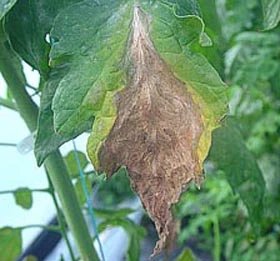
Learn how to control botrytis blight and powdery mildew in greenhouse vegetables.
Botrytis blight usually affects tomato plants at the tip of the younger leaves, causing a water-soaked area. The infected areas of the leaves enlarge and the fungus appears to grow down the leaf petiole into the main stem. The diseased area becomes covered with a fluffy, brownish-gray mold.
Botrytis blight is associated with excessive moisture and high humidity as a result of poor ventilation in covered plant beds and greenhouses. Provide adequate and continuous ventilation, especially during periods of cool, cloudy and wet weather. And keep humidity levels low inside the greenhouse. Other preventive steps include wider plant spacing, continuous introduction of some cold air when house is closed, continuous forced air movement with fans when house is closed, good soil drainage, covering ground with plastic sheets and not using sprinkler irrigation, said Charles W. Averre, Extension Plant Pathologist at North Carolina State University.
Promptly remove all diseased leaves, fruits, or entire plants to avoid spread of disease. Discard debris in a paper bag in a compost pile for use in outdoor cultivation. Do not reintroduce this compost into the greenhouse.
Powdery mildew in greenhouse-grown vegetables can appear at any time and all foliar tissues can be infected. Powdery mildews generally do not require moist conditions to establish and grow, and normally do well under warm conditions, according to the University of California Davis. Powdery mildew first appears as white, powdery spots that may form on both surfaces of leaves, on shoots, and sometimes on flowers and fruit. These spots gradually spread over a large area of the leaves and stems. An exception is one of the powdery mildews that affects artichokes, onions, peppers and tomatoes: it produces yellow patches on leaves but little powdery growth.
Leaves infected with powdery mildew may gradually turn completely yellow, die, and fall off, which may expose fruit to sunburn. On some plants, powdery mildew may cause the leaves to twist, buckle, or otherwise distort. Powdery mildew fungal growth does not usually grow on vegetable fruits, although pea pods may get brownish spots. Severely infected plants may have reduced yields, shortened production times, and fruit that has little flavor.
Powdery mildew spores are carried by wind to new hosts. Although humidity requirements for germination vary, all powdery mildew species can germinate and infect in the absence of free water.

Powdery mildew on curcubit.
BioWorks offers products to control diseases in vegetable production. For timing and rates, click here:
Mike Guy, head grower at Plug Connection, uses RootShield on the company’s organic herb and vegetable program.
“RootShield is like a foundation for our organic herb and vegetable program. By preventing root disease, we are on our way to successful production,” Guy said.
This biopesticide is more environmentally friendly and worker friendly than conventional chemicals, Guy said.
“The 0-hour REI is so helpful in keeping production areas open. Its compatibility with conventional chemicals is very useful in an Integrated Pest Management program,” he said. “We have greatly reduced or limited our use of conventional chemicals by simply having healthy and protected roots.”
Photos courtesy of Photo courtesy of Mississippi State University and UMass Amherst
Latest from Greenhouse Management
- CEA Alliance celebrates bipartisan introduction of Supporting Innovation in Agriculture Act
- Dümmen Orange North America celebrating 25th anniversary in 2025
- Illinois Landscape Contractors Association changes name to Landscape Illinois
- 2025 Proven Winners Horticulture Scholarship applications now open
- ICL’s Gemini Granular herbicide now registered for use in California
- Eurazeo Planetary Boundaries Fund acquires Bioline AgroSciences
- Spring Meadow Nursery's Freedom Shelley finds joy in plants
- Leading Women of Horticulture: Dana Massey, Plantworks Nursery







